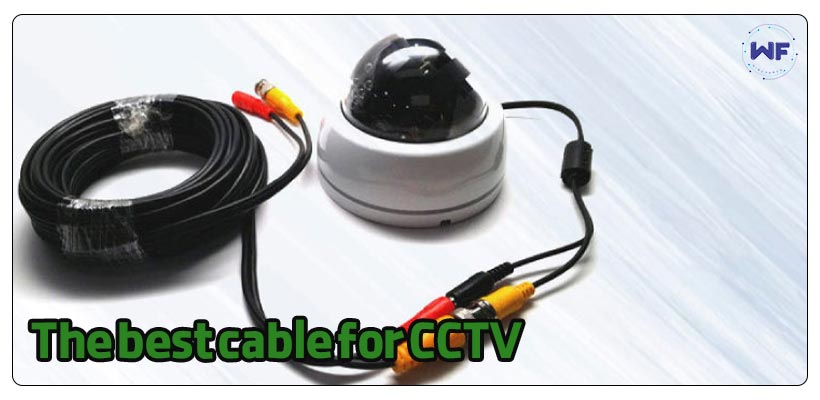The choice of cable for a Closed-Circuit Television (CCTV) system depends on various factors, including the distance between cameras and the recording equipment, the quality of video signal you want to transmit, and the environmental conditions the cables will be exposed to. Two common types of cables used for CCTV installations are:
Coaxial Cable (RG59/RG6)
Coaxial cables are widely used for CCTV installations. RG59 and RG6 are common types of coaxial cables. RG6 has a thicker conductor and offers better signal quality over longer distances compared to RG59. Coaxial cables are suitable for both analog and digital (HD) camera systems. They can transmit video and power over the same cable (using Siamese cables) if needed.
Pros:
- Good signal quality, especially over shorter distances.
- Compatible with various camera types, including analog and digital HD cameras.
- Can carry power and video signals using Siamese cables.
Cons:
- Signal degradation over longer distances, especially with RG59.
- Separate cable required for transmitting power (unless using Siamese cables).
Twisted Pair Cable (UTP/STP)
Twisted pair cables are commonly used for networking purposes, but they can also be used for CCTV installations with the help of video baluns. UTP (Unshielded Twisted Pair) and STP (Shielded Twisted Pair) are the two main types.
Pros:
Can transmit video, audio, and power signals using appropriate adapters.
Can be more cost-effective for longer distances compared to coaxial cables.
Suitable for network-based camera systems.
Cons
Requires additional components like video baluns for proper signal transmission.
May require more technical expertise during installation.
Signal quality and distance capabilities can vary based on the type of cable and quality of baluns used.
When selecting the best cable for your CCTV system, consider the following factors:
Distance:
Coaxial cables (RG6) are generally better for longer distances, while twisted pair cables with video baluns can be used for moderate distances.
Signal Quality:
For higher-resolution cameras, such as HD or 4K, consider cables that can maintain signal integrity over the required distance.
Environment:
Shielded cables (STP) provide better protection against interference in noisy environments, such as areas with high electromagnetic interference.
Installation:
Consider the ease of installation and any additional components (such as baluns) required for the chosen cable type.
Future Expansion:
If you plan to upgrade your CCTV system in the future, consider using cables that can accommodate higher data rates.
when choosing the best cable for your CCTV system:
Cable Quality:
Regardless of the type of cable you choose, investing in high-quality cables can make a significant difference in signal quality and longevity. Poor-quality cables might lead to signal loss, interference, and maintenance issues over time.
Power Requirements:
Determine whether you need to transmit power along with the video signal. Coaxial cables with power conductors (Siamese cables) can simplify installation by combining both power and video transmission in a single cable.
Connectors:
Proper connectors are essential for maintaining signal integrity. Make sure the connectors are of good quality and properly installed to prevent signal degradation and intermittent connections.
Installation Flexibility:
Consider the ease of installation and any limitations of the cable type. Some cables are more flexible and easier to route through walls, conduits, or tight spaces.
Camera Compatibility:
Check the requirements of your cameras. Some cameras might have specific cable recommendations based on their technology and power consumption.
Budget:
Different cable types have varying costs. Coaxial cables tend to be more affordable, but if your installation requires long distances, using video baluns and twisted pair cables might be a cost-effective solution.
Interference:
If your installation site has a lot of electromagnetic interference, such as from other electronics or power sources, consider using shielded cables (STP) to minimize signal degradation.
Future-Proofing:
As technology advances, cameras with higher resolutions and data rates may become more common. Choosing cables with higher bandwidth capabilities can help future-proof your installation.
Weather Resistance:
If the cables will be installed outdoors, make sure they are designed to withstand environmental factors like moisture, UV exposure, and temperature variations.
Consult Professionals:
If you’re unsure about which cable to choose, it’s advisable to consult with professionals or technicians who specialize in CCTV installations. They can provide tailored advice based on your specific needs and the conditions of your installation site.
Remember that the effectiveness of your CCTV system depends not only on the cables you choose, but also on proper installation, cable management, and maintenance. It’s important to strike a balance between your budget, installation requirements, and desired signal quality to ensure the success of your CCTV system.
Ultimately, the best cable for your CCTV system will depend on your specific requirements and budget. It’s recommended to consult with a professional CCTV installer or technician who can assess your needs and recommend the most suitable cable type for your installation.


